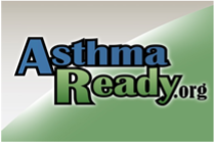
Asthma Ready Communities Education Series
- Registration Closed
The Asthma Ready Communities Education Series is presented in two parts and covers six main topics relevant to understanding and managing asthma.
- Asthma Overview Part 1 addresses What is asthma?, Asthma Signs and Symptoms, and Asthma Triggers.
- Asthma Overview Part 2 addresses Asthma Medications, Inhalation Technique, and Asthma Action Plans.
These educational modules were developed with support from both the Mid-America Pediatric Environmental Health Specialty Unit and the Asthma Ready Communities at the University of Missouri.


Mid-America Pediatric Environmental Health Specialty Unit
These videos were supported by cooperative agreement FAIN: NU61TS000296 from the Centers for Disease Control and Prevention/Agency for Toxic Substances and Disease Registry (CDC/ATSDR). The U.S. Environmental Protection Agency (EPA) provided support through Inter-Agency Agreement DW-75-95877701 with CDC/ATSDR. The American Academy of Pediatrics supports the Pediatric Environmental Health Specialty Units as the National Program Office. The findings and conclusions in this presentation have not been formally disseminated by CDC/ATSDR or EPA and should not be construed to represent any agency determination or policy. Use of trade names that may be mentioned is for identification only and does not imply endorsement by the CDC/ATSDR or EPA.
Asthma Ready® Communities, University of Missouri
Funding for these videos were also provided in part by the US Centers for Disease Control and Prevention cooperative agreement number NUE1EH001393. Its contents are solely the responsibility of the authors and do not necessarily represent the official views of the Centers for Disease Control and Prevention or the Department of Health and Human Services.
Course Syllabus | Asthma Overview, Part 1 & 2
Asthma Overview | Part 1
Asthma Overview: Part 1, includes three sections: What is Asthma?, Asthma Signs and Symptoms, and Asthma Triggers.
What is asthma?
This first section explains what asthma is and how it affects breathing. It will show short cartoon messages (vignettes) that cover asthma concepts and how to improve asthma control. It also includes illustrations of a normal airway vs changes in the airway of someone with asthma that is not well controlled and introduces the concept of environmental triggers. Upon completion, the learner should be able to:
- Describe the main components of asthma and how it affects breathing
- Describe environmental triggers and their effects on the airways
- Explain what measures can be used so asthma is well controlled
Asthma Signs and Symptoms
This second section discusses common asthma signs and symptoms of an asthma episode, how asthma control is defined, and the importance of asthma education, particularly in recognizing the symptoms of an episode (or can be referred to as an attack, flare, or exacerbation) and prompt treatment. Upon completion, the learner should be able to:
- Describe at least three common symptoms of asthma
- Define ways to assess asthma symptoms and interference with activities
- Describe how asthma control is defined
Asthma Triggers
Preventing signs and symptoms is important in asthma management, and one component of that is trigger avoidance or reduction. This third section discusses asthma triggers – what they are, provides some examples, and where they are commonly found. Upon completion, the learner should be able to:
- Describe how asthma triggers cause symptoms
- Define types of triggers
- List common asthma triggers and some reduction and remediation strategies
Asthma Overview | Part 2
Asthma Overview: Part 2, includes three sections: Asthma Medications, Inhalation Technique, and Asthma Action Plans.
Asthma Medications
The fourth section identifies the different types of asthma medications including quick relief, control, and emergency medicines and when to use these medications. Upon completion, the learner should be able to:
- Identify the different types of medicines used to treat asthma
- Discuss when to take asthma medication
- Explain some common side effects of asthma medication and measures to reduce these side effects
Inhalation Technique
The fifth section reviews how inhaler medication should be taken and the importance of using a valved holding chamber with a metered-dose inhaler (MDI). This module also shows an inhalation coaching session. Upon completion, the learner should be able to:
- Discuss why good inhalation technique is needed when taking inhaler medication
- Explain why using a valved holding chamber (a type of spacer) is useful with a metered-dose inhalers
- Describe why a daily inhaled corticosteroid is so important to control asthma
Asthma Action Plans
An asthma action plan (AAP) is a tool that guides how to manage asthma, recognize symptom severity, and what steps should be taken to respond to the symptoms. The plan is organized like a traffic light. The sixth section discusses what an AAP is, its purpose, how it is used, and how to interpret the green, yellow, and red zones. Upon completion, the learner should be able to:
- Describe the three zones of an asthma action plan
- Explain what actions should be taken in each zone
- Describe the signs and symptoms when emergency care is required
- List which members of the care team should have a copy of the AAP
Rebecca Brown MPA, AE-C, RRT
Respiratory Therapist, Certified Asthma Educator
Rebecca Brown, MPA, RRT, AE-C, is a respiratory therapist and certified asthma educator. A respiratory therapist since 2001, and a certified asthma educator since 2014, she coordinates community-based asthma education delivery with schools and clinics. This coordination involves training, ongoing support, and practice facilitation to school nurses and clinicians to increase their understanding and delivery of self-management asthma educations. She has been working with Asthma Ready Communities as a Regional Coordinator in Kansas City Region since 2012, and through this partnership, has also worked with school districts with the Missouri Asthma Prevention and Control Program. Within the Asthma Care Accelerator ECHO Program, Rebecca serves as the Asthma Day Coordinator.
